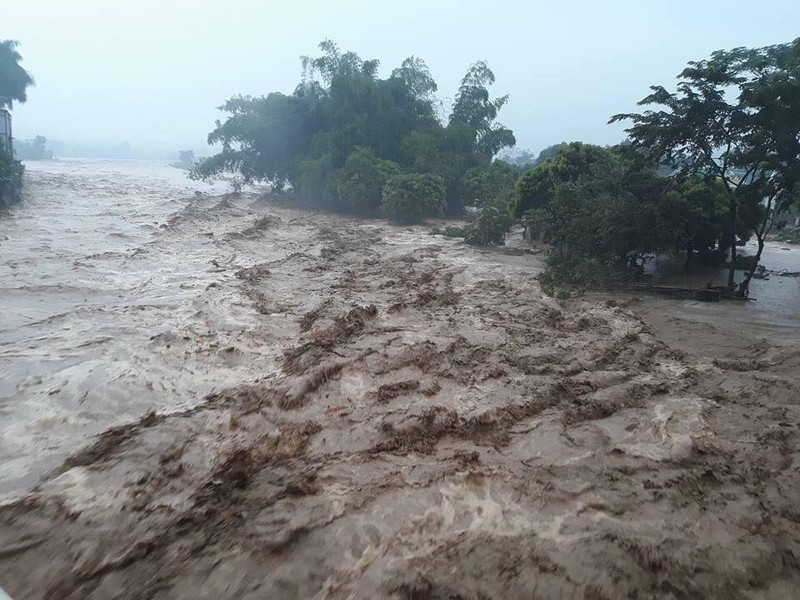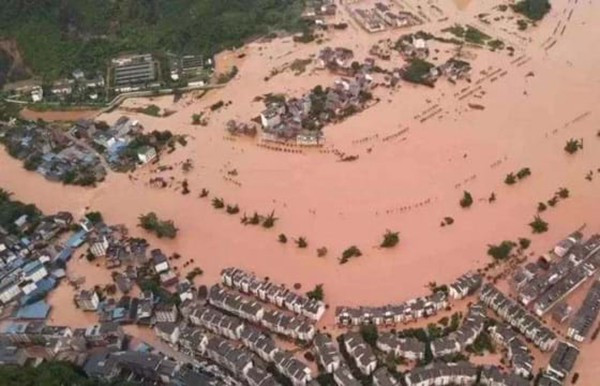Heavy rain in southern China, then coming to Vietnam?
Meteorological experts say that after heavy rain in southern China, this phenomenon will occur in Vietnam.
After the drought there will be a big flood.
According to statistics from the National Center for Hydro-Meteorological Forecasting, over the past 20 years, after droughts, major floods have frequently occurred.
Specifically, there were 10 widespread droughts in the years: 1993-1994, 1994-1995, 1995-1996, 1997-1998, 2001-2002, 2004-2005, 2006-2007, 2009-2010, 2015-2016 and 2019-2020.
|
| Image of flood in Hoang Long river in 2017. Illustration: Nghiem Anh Hai. |
In the above years, historical floods appeared on the Da River in 1996, Gianh River, Thu Bon River in 2007 and Hoang Long River in 2017. Large-scale floods on many rivers appeared in 1996, 2002, 2005, 2006, 2008, 2010, 2016, 2017, showing a certain relationship between the years of large floods appearing in the flood season right after the year of severe drought.
In particular, in the past 15 - 20 years, there have been 4 severe droughts with a recurrence cycle of about 5 years and then large-scale floods appeared: In 2006 (after the drought of 2004 - 2005), they appeared from Ha Tinh to Binh Dinh, with the peak being 6/9 rivers on BĐ3.
In 2010 (after the 2009-2010 drought), large floods appeared from Nghe An to Ninh Thuan, with flood peaks at 8/9 in the area above BĐ3; In 2016 (after the record drought of 2015-2016), large floods appeared on a large scale from Quang Binh to Ninh Thuan, with flood peaks at 6/9 in the area above BĐ3.
According to general assessment, total monthly rainfall tends to be approximately equal to and lower than the average annual rainfall. However, actual data shows that heavy rain in a short period of time with a total rainfall lower than the total monthly rainfall has caused large and especially large floods.
|
| Mr. Mai Van Khiem - Director of National Center for Hydro-Meteorological Forecasting. |
Mr. Mai Van Khiem - Director of the National Center for Hydro-Meteorological Forecasting commented: "With such statistical signs, there is a basis to assess the complexity in the direction of large floods on river systems during the flood season this year and in 2021".
In addition, in recent times, due to drought, many provinces and cities in the Central and Southern regions have built many temporary dams to raise water levels for water intake and salt prevention; key reservoirs have not been reinforced (mainly small reservoirs).
It is estimated that the flood in the Mekong River’s upstream is not large, but because the rivers and canals have been narrowed, the flow velocity will increase, increasing the risk of breaking these temporary dams and dikes. “Therefore, it is recommended that provinces and cities have plans to remove fragile temporary dams and reinforce weak dikes and reservoirs before the flood season,” Mr. Khiem suggested.
According to Mr. Khiem, the floods in the North will be concentrated in September and October 2020, the rainy season will come late and may end early. In the North Central region, heavy rains are likely to be concentrated in the period from late September to early November 2020. The North is likely to have few storms, but the Central region will have more storms in the second half of the year.
The second half of 2020 will have a lot of rain and big floods
Mr. Mai Van Khiem - Director of the National Center for Hydro-Meteorological Forecasting said that the first half of 2020 will be hot and sunny nationwide, the second half of the year will likely have heavy rain and major floods.
|
| Heavy rain over the past several days has caused severe flooding in 26 provinces in China. Photo: Weibo. |
“It is noteworthy that at this time, Southern China is experiencing heavy flooding. According to the rule, when there is heavy rain in Southern China, only 1-2 months later there will be very heavy rain in Vietnam. At this time, the northern mountainous provinces, especially Ha Giang and Cao Bang, are experiencing large clouds, possibly in the near future there will be flash floods in this area,” Mr. Khiem commented.
According to the National Center for Hydro-Meteorological Forecasting, heavy rains will be concentrated in the last period of the year, concentrated in the Central and South Central regions. In July 2020, total rainfall in the area from Thanh Hoa to Thua Thien Hue was 10-25% lower, and in the area from Da Nang to Binh Thuan was 10-20% higher than the average of many years (TBNN). In October - November 2020, the area from Thanh Hoa to Quang Binh was approximately at the average level, and in the area from Quang Tri to Binh Thuan was 15-40% higher. In December 2020, the rainfall in the North and Central Central regions was 15-30% lower, and in the South Central region was 20-40% higher.
In the Central Highlands and the South, from July to September 2020, the total amount ofRainfall (TLM) is generally at a level approximately equal to the average for the same period. In October, November, and December 2020, TLM is generally 15-30% higher than the average; in the Central Highlands region in November 2020, TLM is 30-50% higher than the average. The rainy season in the Central Highlands and the South is likely to end later than average.
The flood peak in 2020 on the Northern rivers is generally at level 1-2, especially on the Thao River, Hoang Long River and small rivers from level 2-3, the lower Red River in Hanoi and the lower Thai Binh River are at level below level 1. Flash floods and landslides are at high risk in mountainous areas, especially in the Northwest region.
The flood peak in 2020, in the downstream of the main rivers from Thanh Hoa to Ha Tinh is at level BĐ1-BĐ2, approximately the average flood peak; rivers from Quang Binh to Binh Thuan and the Central Highlands region are at level BĐ2-BĐ3, some rivers are above BĐ3, equivalent to the average flood peak. On small rivers and streams, the upstream areas of rivers are likely to experience major floods, flash floods and landslides.
The flood peak in 2020, at the headwaters of the Mekong River on the Tien River at Tan Chau and the Hau River at Chau Doc is at level BĐ1-BĐ2, 0.2-0.4m lower than the average flood peak. The annual flood peak will appear in the second half of September 2020.



